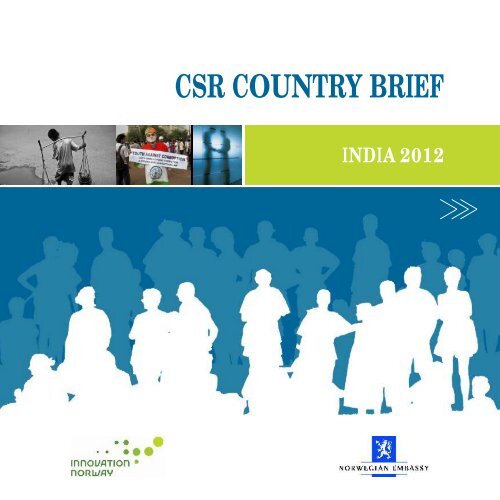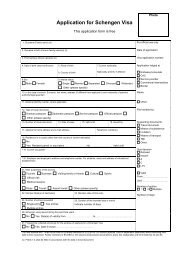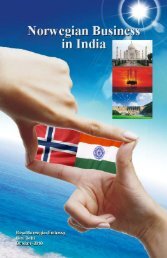csr 2012.pdf - Norway - the official site in India
csr 2012.pdf - Norway - the official site in India
csr 2012.pdf - Norway - the official site in India
You also want an ePaper? Increase the reach of your titles
YUMPU automatically turns print PDFs into web optimized ePapers that Google loves.
CSR COUNTRY BRIEFINDIA 2012
Executive SummaryThis CSR Country Brief for <strong>India</strong> focuses onspecific factors relevant for Norwegiancompanies wish<strong>in</strong>g to implement CSRsuccessfully <strong>in</strong> <strong>the</strong>ir <strong>India</strong> operations. Theconditions for bus<strong>in</strong>ess operations <strong>in</strong> <strong>India</strong>vary from <strong>Norway</strong> <strong>in</strong> many areas, andconsequently, so will <strong>the</strong> way CSR is perceivedand implemented.The ma<strong>in</strong> focus of this report is on countryspecific and cultural differences between<strong>Norway</strong> and <strong>India</strong> and <strong>the</strong>ir impact onpartnerships, transparency and corruption, and on <strong>the</strong> <strong>in</strong>formal bus<strong>in</strong>ess sector and its impact on commerce.Moreover, we have provided an overview of <strong>the</strong> <strong>in</strong>itiatives from <strong>the</strong> <strong>India</strong>n government for improv<strong>in</strong>g conditionsfor corporate social responsibility <strong>in</strong> <strong>India</strong> before we conclude by giv<strong>in</strong>g some advice on how to fur<strong>the</strong>r develop oradapt your own CSR policy.We have also done our best to provide you with useful l<strong>in</strong>ks, an overview of <strong>the</strong> voluntary guidel<strong>in</strong>es result<strong>in</strong>g from<strong>the</strong> Global Compact <strong>in</strong>itiative <strong>in</strong> <strong>India</strong> and <strong>the</strong> World Bank do<strong>in</strong>g bus<strong>in</strong>ess report for <strong>India</strong>. Information on relevantlaws and guidel<strong>in</strong>es that may be of <strong>in</strong>terest for you when do<strong>in</strong>g bus<strong>in</strong>ess <strong>in</strong> <strong>India</strong> has also been <strong>in</strong>cluded.We advise Norwegian companies operat<strong>in</strong>g <strong>in</strong> <strong>India</strong> to prioritize due diligence when select<strong>in</strong>g partners, staff andlocal agents, and to verify and follow up <strong>the</strong>ir sourc<strong>in</strong>g, logistics and production value cha<strong>in</strong>. Health, Safety andEnvironmental measures may be more challeng<strong>in</strong>g to implement <strong>in</strong> <strong>India</strong> than <strong>in</strong> <strong>Norway</strong>. We recommend you toset aside enough time to learn to know your <strong>India</strong>n partners, mean<strong>in</strong>g how <strong>the</strong>y operate as well as <strong>in</strong> regards to<strong>the</strong>ir perception of CSR. Fur<strong>the</strong>rmore, be<strong>in</strong>g aware of <strong>the</strong> relevant laws and CSR-related <strong>in</strong>stitutions relevant foryour company may improve your ease of do<strong>in</strong>g bus<strong>in</strong>ess <strong>in</strong> <strong>India</strong> as well as ensur<strong>in</strong>g that your CSR policy is <strong>in</strong> l<strong>in</strong>ewith <strong>the</strong> recent trends <strong>in</strong> <strong>India</strong>.The implementation of CSR <strong>in</strong> your bus<strong>in</strong>ess operations will be more challeng<strong>in</strong>g <strong>in</strong> <strong>India</strong> than <strong>in</strong> <strong>Norway</strong>. However,please have <strong>in</strong> m<strong>in</strong>d <strong>the</strong> large potential you have for mak<strong>in</strong>g a significant and positive contribution to <strong>the</strong> localenvironment <strong>in</strong> <strong>India</strong>, and your ability to improve <strong>the</strong> conditions for your employees, your suppliers and yourpartner's performance through implement<strong>in</strong>g proper CSR <strong>in</strong> <strong>the</strong>ir daily operations.
IntroductionWhat steps has your company taken to ensure that your company andyour suppliers do not use child labour? Does your company have apolicy aga<strong>in</strong>st corruption, and how do you implement it <strong>in</strong> practice?Are <strong>the</strong> health and safety standards of your company and of yoursuppliers <strong>in</strong> accordance with <strong>in</strong>ternational HSE standards? As aNorwegian company operat<strong>in</strong>g <strong>in</strong> <strong>India</strong>, your stakeholders expect youto be able to answer <strong>the</strong>se questions.Do<strong>in</strong>g bus<strong>in</strong>ess responsibly <strong>in</strong> <strong>India</strong> is challeng<strong>in</strong>g and requires constantattention from management. Norwegian companies cannot expect <strong>the</strong> samelevel of public regulation and monitor<strong>in</strong>g of <strong>the</strong>ir activities <strong>in</strong> <strong>India</strong> as <strong>the</strong>y do <strong>in</strong> <strong>Norway</strong>, and must <strong>the</strong>refore ensure for<strong>the</strong>mselves that social and environmental practices meet Norwegian and <strong>in</strong>ternational norms and expectations. Fail<strong>in</strong>g tomeet <strong>the</strong>se expectations may negatively impact your company's reputation and harm your relations with employees,customers, <strong>in</strong>vestors, partners, media and <strong>the</strong> local community. In this country brief on Corporate Social Responsibility (CSR)<strong>in</strong> <strong>India</strong>, Innovation <strong>Norway</strong> <strong>the</strong>refore provides Norwegian companies with <strong>in</strong>formation and advice on how to practice CSR <strong>in</strong>an <strong>India</strong>n bus<strong>in</strong>ess context.What is Corporate Social Responsibility (As def<strong>in</strong>ed <strong>in</strong> <strong>the</strong> Norwegian government white paper on CSR)Over <strong>the</strong> years <strong>the</strong>re have been different views of <strong>the</strong> role and responsibilities of bus<strong>in</strong>ess <strong>in</strong> society. Some have argued that«<strong>the</strong> bus<strong>in</strong>ess of bus<strong>in</strong>ess is bus<strong>in</strong>ess», and that <strong>the</strong> private sector benefits society best by concentrat<strong>in</strong>g on <strong>in</strong>creas<strong>in</strong>g itsprofitability with<strong>in</strong> a clear legal framework. The rationale here is that companies operat<strong>in</strong>g <strong>in</strong> a well-function<strong>in</strong>g marketcontribute to achiev<strong>in</strong>g broader social goals such as employment, general development and welfare, <strong>the</strong>reby mak<strong>in</strong>g <strong>the</strong>ircontribution to society.In recent years, CSR has come to encompass more. This relates to <strong>the</strong> <strong>in</strong>creas<strong>in</strong>g <strong>in</strong>fluence of <strong>the</strong> private sector as a result ofglobalisation, and <strong>the</strong> opportunities and challenges associated with this. Corporate social responsibility, with its attendantnorms and standards, is evolv<strong>in</strong>g constantly as new knowledge is acquired.At <strong>the</strong> core of <strong>the</strong> concept lies <strong>the</strong> responsibility of companies towards people, society and <strong>the</strong> environment that are affectedby <strong>the</strong>ir activities.Companies that deal with <strong>the</strong>ir social responsibility <strong>in</strong> a forward-look<strong>in</strong>g manner ensure that becomes an <strong>in</strong>tegral aspect of<strong>the</strong>ir corporate governance. CSR must be clearly established as a l<strong>in</strong>e management responsibility, and followed up on anongo<strong>in</strong>g basis by <strong>the</strong> company's senior management and board.There are various strategic approaches to CSR. Some emphasise risk management, for <strong>in</strong>stance through reputationmanagement. O<strong>the</strong>rs advocate a more proactive approach to CSR, where f<strong>in</strong>d<strong>in</strong>g solutions to social problems becomes partof <strong>the</strong> company's bus<strong>in</strong>ess strategy, <strong>the</strong>reby provid<strong>in</strong>g access to important markets. Quite apart from <strong>the</strong> company'scontribution to society through job creation, taxation and generat<strong>in</strong>g economic spillover effects, <strong>the</strong> company can developproducts, services, production methods and bus<strong>in</strong>ess practices that promote development. Examples of this <strong>in</strong>clude microcredit, mobile telecommunications, solar power and water supply.
The substance and understand<strong>in</strong>g of <strong>the</strong> concept of CSR are dynamic. The focal issues vary accord<strong>in</strong>g to <strong>the</strong> area of activity <strong>in</strong>question, and change over time. Philanthropy, or donat<strong>in</strong>g to good causes, has traditionally been perceived as an expressionof a company's commitment to corporate social responsibility. Many companies cont<strong>in</strong>ue to view CSR <strong>in</strong> terms of charity andsupport to <strong>the</strong> local community. However, <strong>the</strong>re is a grow<strong>in</strong>g tendency to see <strong>the</strong> core area for practis<strong>in</strong>g social responsibilityas <strong>the</strong> company's own operations and supply cha<strong>in</strong>.CSR <strong>in</strong> <strong>India</strong>As a nation, <strong>India</strong> faces paradoxes and polarities. On <strong>the</strong>, Human Development Index 2011 <strong>India</strong> ranks at <strong>the</strong> lower end, at ath134 of 187countries.Inequality between genders is strong, more than 30 per cent of <strong>the</strong> <strong>India</strong>n population is illiterate andmore than one third of <strong>the</strong> population lives on less than a dollar and a quarter a day. At <strong>the</strong> same time <strong>India</strong> takes pride <strong>in</strong> <strong>the</strong>fact that she has made a mark on <strong>the</strong> scientific world map. <strong>India</strong> boasts of <strong>the</strong> world's third largest educated and technicalmanpower, and is reckoned as an economic power house. It is a progressive country, and <strong>in</strong>clusive growth is at <strong>the</strong> centre of<strong>India</strong>'s national agenda.Corporate Social Responsibility (CSR) has been on <strong>the</strong> agenda <strong>in</strong> <strong>India</strong> for a considerable period of time, and most big <strong>India</strong>ncorporations are engaged <strong>in</strong> CSR activities. However, among <strong>the</strong> many SMEs <strong>the</strong>re are scarce resources available and CSRmay be considered too costly. Be<strong>in</strong>g exporters, <strong>the</strong>se SMEs will frequently do bus<strong>in</strong>ess with Norwegian companies. If yourcompany chose to do bus<strong>in</strong>ess with <strong>India</strong>n companies with poor social and environmental standards, it can attract negativeattention from media, customers, <strong>in</strong>vestors, employees and <strong>the</strong> authorities.Fur<strong>the</strong>rmore, employer's organisations can have different roles and attitudes than we are used to from <strong>Norway</strong>. The <strong>India</strong>nmanagement style is considered to be more authoritarian than <strong>the</strong> Norwegian one, and it might be considered bothunnecessary and improper to ask employees about <strong>the</strong>ir op<strong>in</strong>ions. However, <strong>India</strong>n managers are considered extremelyprofessional, and <strong>India</strong>n companies have a hierarchical organisational structure, with many levels of management.The <strong>India</strong>n society has a long-term perspective, and is based on <strong>in</strong>formal and predictable relations, <strong>in</strong> which trust plays animportant role.Cultural differences may also impact how CSR is perceived from <strong>the</strong> <strong>India</strong>n side <strong>in</strong> a partnership, and how CSR is implementedand communicated. How agreements are followed up and <strong>in</strong>terpreted is ano<strong>the</strong>r area where cultural differences may have astrong impact. CSR often takes <strong>the</strong> form of philanthropy among <strong>India</strong>n agents, but this does not necessarily mean that <strong>the</strong>reis little potential for implement<strong>in</strong>g CSR <strong>in</strong> your bus<strong>in</strong>ess practices <strong>in</strong> <strong>India</strong>.Take time to know your <strong>India</strong>n partner and how <strong>the</strong> company operates.A potential area for synergies lies <strong>in</strong> <strong>the</strong> meet<strong>in</strong>g between <strong>the</strong> measurement and communication skills found <strong>in</strong> Norwegiancompanies and <strong>the</strong> more relationship-focused bus<strong>in</strong>ess practices of <strong>the</strong>ir <strong>India</strong>n partners.Both <strong>the</strong> Norwegian and <strong>the</strong> <strong>India</strong>n government are push<strong>in</strong>g for stronger policies <strong>in</strong> relation to corporate responsibility. Witha strong CSR profile, Norwegian bus<strong>in</strong>esses operat<strong>in</strong>g <strong>in</strong> <strong>India</strong> have <strong>the</strong> potential to be at <strong>the</strong> forefront of this development,and to <strong>in</strong>crease <strong>the</strong>ir ability to tackle market specific challenges while streng<strong>the</strong>n<strong>in</strong>g <strong>the</strong>ir triple bottom l<strong>in</strong>e – <strong>the</strong>environmental, social and economic dimensions of <strong>the</strong> bus<strong>in</strong>ess.
Supply Cha<strong>in</strong> ManagementThe implementation of CSR <strong>in</strong> your bus<strong>in</strong>ess operations ismore challeng<strong>in</strong>g <strong>in</strong> <strong>India</strong> than <strong>in</strong> <strong>Norway</strong>. Only about 10% of<strong>the</strong> total <strong>India</strong>n workforce is employed <strong>in</strong> formal (organized)companies. A number of companies with<strong>in</strong> <strong>the</strong>se 10%,especially <strong>the</strong> largest ones, have already implemented a fairlygood level of CSR, particularly related to Health, Safety andEnvironment (HSE). The rest of <strong>the</strong> workforce is employed by<strong>in</strong>formal (unorganized) companies, or are home-based workersbelong<strong>in</strong>g to <strong>the</strong> vast “peoples' sector”.The workforce <strong>in</strong> <strong>the</strong> <strong>in</strong>formal sector is used as sub-contractors, and a substantial amount of <strong>the</strong> <strong>India</strong>n productionis be<strong>in</strong>g put out to this sector through contractual and sub-contractual arrangements. This vast workforce found <strong>in</strong><strong>the</strong> <strong>in</strong>formal economy is not covered by <strong>India</strong>n protective legislation, and it has generally a low level of education.Moreover, <strong>the</strong>se workers operate <strong>in</strong> work<strong>in</strong>g environments with scarcely implemented CSR systems, <strong>in</strong>clud<strong>in</strong>g HSEsystems. The people's sector is also where you f<strong>in</strong>d a high amount of child labour, an area <strong>in</strong> which <strong>India</strong> tops <strong>the</strong>world statistics. We advise Norwegian companies operat<strong>in</strong>g <strong>in</strong> <strong>India</strong> to prioritize due diligence when select<strong>in</strong>gpartners, staff and local agents, and to verify and follow up <strong>the</strong>ir sourc<strong>in</strong>g, logistics and production value cha<strong>in</strong>.Norwegian companies operat<strong>in</strong>g <strong>in</strong> <strong>India</strong> should <strong>the</strong>refore use time and resources to understand and follow up<strong>the</strong>ir production value-cha<strong>in</strong>.For practical advice on supply cha<strong>in</strong> management, please see <strong>the</strong> Ethical Trad<strong>in</strong>g Initiative's guide on supply cha<strong>in</strong>management, available at www.etiskhandel.noThe UN Global CompactThe United Nations Global Compact is a strategic policy <strong>in</strong>itiative for bus<strong>in</strong>esses that arecommitted to align<strong>in</strong>g <strong>the</strong>ir operations and strategies with ten universally acceptedpr<strong>in</strong>ciples <strong>in</strong> <strong>the</strong> areas of human rights, labour, environment and anti-corruption(www.unglobalcompact.org).The Global Compact provides strategic advice and practical tools for companies work<strong>in</strong>g withCSR, and has local networks both <strong>in</strong> <strong>the</strong> Nordic region and <strong>in</strong> <strong>India</strong>.For more <strong>in</strong>formation, please see <strong>the</strong> web<strong>site</strong> for <strong>the</strong> Nordic Global Compact networkwww.gcnordic.net and <strong>the</strong> <strong>India</strong>n Network: www.globalcompact<strong>in</strong>dia.org.
The International Organization ofStandardization (ISO) has alsodeveloped a comprehensive guidel<strong>in</strong>e toassist companies <strong>in</strong> <strong>the</strong> implementationof CSR: ISO 26000 Guidance on SocialResponsibility, available at www.iso.org.A Norwegian version (NS-ISO 26000) isavailable from Standard Norge(www.standard.no).CSR Initiatives <strong>in</strong> <strong>India</strong>Several major CSR <strong>in</strong>itiatives have beenlaunched <strong>in</strong> <strong>India</strong> s<strong>in</strong>ce <strong>the</strong> mid-1990s. Among <strong>the</strong> first is <strong>the</strong> voluntary code of corporate governance, “DesirableCorporate Governance: A Code”, established <strong>in</strong> April 1998. This was an <strong>in</strong>itiative by <strong>the</strong> Confederation of <strong>India</strong>nIndustry (CII), <strong>India</strong>'s largest <strong>in</strong>dustry and bus<strong>in</strong>ess association.The FICCI - Aditya Birla CSR Centre for Excellence <strong>in</strong> New Delhi was launched on February 17, 2010. This is one ofseveral <strong>in</strong>itiatives that will motivate CSR to be an even more <strong>in</strong>tegral part of <strong>the</strong> <strong>India</strong>n corporate culture <strong>in</strong> <strong>the</strong>years to come. FICCI (Federation of <strong>India</strong> Chamber on Commerce and Industry) has cooperation agreements withboth NHO (The Confederation of Norwegian Bus<strong>in</strong>ess and Industry) and Innovation <strong>Norway</strong>.On March 16, 2010 The Global Compact Local Network <strong>India</strong> hosted “The Asia - Pacific Regional Conclave” <strong>in</strong> NewDelhi on <strong>the</strong> topic of “Enhanc<strong>in</strong>g Enterprise Value through <strong>the</strong> Global Compact” attract<strong>in</strong>g over 500 delegates from21 countries, <strong>in</strong>clud<strong>in</strong>g dozens of top leaders from Government, bus<strong>in</strong>ess and civil society. The strong Governmentsupport to this Conclave is <strong>in</strong> l<strong>in</strong>e with recent steps by <strong>the</strong> Government of <strong>India</strong> to advance susta<strong>in</strong>ability <strong>in</strong> <strong>the</strong>country.National Foundation for Corporate Governance (NFCG) is a body which promotes CSR and raises <strong>the</strong> standards ofcorporate governance practices <strong>in</strong> <strong>India</strong>. The M<strong>in</strong>istry of Corporate Affairs has released <strong>the</strong> second version of <strong>the</strong>National Voluntary Guidel<strong>in</strong>es on Social, Environmental and Economic Responsibilities <strong>in</strong> l<strong>in</strong>e with <strong>the</strong> GlobalCompact Network <strong>India</strong> (See Summary of Guidel<strong>in</strong>es and Pr<strong>in</strong>ciples or Attachment 2, and National VoluntaryGuidel<strong>in</strong>es 2011 for <strong>the</strong> full report).
Human RightsHuman rights violations are a crucial CSR concern for companies, and Norwegiancompanies should support and respect human rights and ensure that <strong>the</strong>y are notcomplicit <strong>in</strong> human rights abuses <strong>in</strong> <strong>India</strong>. Amnesty International is an <strong>in</strong>dependentorganisation promot<strong>in</strong>g human rights, and provides updated <strong>in</strong>formation on <strong>the</strong>human rights situations <strong>in</strong> <strong>in</strong>dividual countries: www.amnesty<strong>in</strong>ternational.org.The UN Global Compact also offers practical advice and programmes for “Bus<strong>in</strong>essand Human Rights”: www.unglobalcompact.orgHuman rights <strong>in</strong> <strong>India</strong> are covered under “The Protection of Human Rights Act, 1993 (As amended by <strong>the</strong>Protection of Human Rights (Amendment) Act, 2006-No. 43 of 2006)”. This is handled by <strong>the</strong> “National HumanRights Commission” see (http://nhrc.nic.<strong>in</strong>/ ). In this webpage you will also f<strong>in</strong>d a copy of <strong>the</strong> above mentionedHuman Rights Act. Cont<strong>in</strong>uous attempts are be<strong>in</strong>g made by <strong>the</strong> Commission to address various Human Rightsissues, and some of <strong>the</strong>se are be<strong>in</strong>g monitored as Programmes under <strong>the</strong> directions of <strong>the</strong> Supreme Court.Child Labour<strong>India</strong> is a member of <strong>the</strong> International Labour Organization, and has ratified 40 of <strong>the</strong> ILO conventions. However,<strong>India</strong> has not ratified <strong>the</strong> ILO core conventions relat<strong>in</strong>g to child labour:o 138 M<strong>in</strong>imum Age Convention (1973)o 182 Elim<strong>in</strong>ation of <strong>the</strong> Worst Forms of Child Labour (1999)<strong>India</strong>'s domestic law on child labour, Child Labour (Prohibition and Regulation) Act (1986), bans employment ofchildren <strong>in</strong> some dangerous occupations, such as factories and m<strong>in</strong>es, and regulates <strong>the</strong> work<strong>in</strong>g conditions <strong>in</strong>o<strong>the</strong>rs. Accord<strong>in</strong>g to this law, anyone above <strong>the</strong> age of 14 will be regarded as an adult and will not be protected by<strong>the</strong> child labour regulations.Accord<strong>in</strong>g to UNICEF, <strong>in</strong>sufficient attention has been given <strong>in</strong> <strong>India</strong> to elim<strong>in</strong>ate <strong>the</strong> worst forms of child labour. The1986 child labour law does not cover children <strong>in</strong> all sectors. <strong>India</strong> has <strong>the</strong> world'shighest number of child labourers less than 14 years of age.The prevalence of child labour <strong>in</strong>creases <strong>the</strong> need for firms to pay close attention to<strong>the</strong> suppliers and clusters <strong>in</strong> <strong>the</strong> value cha<strong>in</strong>. Your company needs to take measuresto prevent and reduce <strong>the</strong> risk of child labour, for <strong>in</strong>stance <strong>in</strong>clud<strong>in</strong>g a code ofconduct as a part of <strong>the</strong> firm's agreement with suppliers. Your company should alsohave an action plan for situations where child labour is uncovered <strong>in</strong> your supplycha<strong>in</strong>, for <strong>in</strong>stance by provid<strong>in</strong>g alternatives to <strong>the</strong> families <strong>in</strong> question, such assupport for education/tra<strong>in</strong><strong>in</strong>g, micro credit loans to parents. The InternationalLabour Organization provides <strong>in</strong>formation and practical advice on how companiesshould approach child labour: www.ilo.org
Labour Laws and Right of Organization<strong>India</strong> has altoge<strong>the</strong>r ratified at least 333 labour laws, but not <strong>the</strong> ILO core conventions related to <strong>the</strong> right ofOrganization:o 087 Freedom of Association and Protection of <strong>the</strong> Right to Organize (1948)o 098 Right to Organize and Collective Barga<strong>in</strong><strong>in</strong>g (1949)Fur<strong>the</strong>rmore, <strong>the</strong> way <strong>India</strong>n labour laws are supervised and implemented varies. The country was <strong>in</strong> 1976 <strong>the</strong> firstcountry <strong>in</strong> <strong>the</strong> South Asian region to enact legislation aga<strong>in</strong>st bonded labour, a form of slavery <strong>in</strong> which a personpledges him/herself to work to pay off a loan. Such contracts can be passed on through generations. Contractlabour, e.g. workers that are not employed by <strong>the</strong> organization but hired for a specific task or project, is ano<strong>the</strong>rcomplex area, and sub-contract<strong>in</strong>g is especially common <strong>in</strong> <strong>India</strong>. These contract workers do not get <strong>the</strong> sameprotection and benefits as <strong>the</strong> permanent workers, and many work as contract labour for longer periods of time.The fact that, as mentioned, 90% of <strong>the</strong> <strong>India</strong>n labour is <strong>in</strong> <strong>the</strong> <strong>in</strong>formal sector, <strong>the</strong>y will have weak protection bylabour regulations.Although <strong>the</strong> ILO Conventions related to forced labour have been ratified, certa<strong>in</strong> forms of bonded labour stillpersists, especially <strong>in</strong> <strong>the</strong> <strong>in</strong>formal sector. Most <strong>India</strong>n states have enforced an act for m<strong>in</strong>imum wages forlabourers <strong>in</strong> scheduled employment, as stipulated <strong>in</strong> <strong>the</strong> M<strong>in</strong>imum Wage Act from 1948. However, <strong>the</strong> m<strong>in</strong>imumwage is often not paid. Accord<strong>in</strong>g to ILO, labour under m<strong>in</strong>imum wage is considered a form of bonded labour, and<strong>the</strong>y claim that <strong>the</strong>re is a stagger<strong>in</strong>g amount of bonded labourers <strong>in</strong> <strong>India</strong>, particularly <strong>in</strong> <strong>the</strong> sou<strong>the</strong>rn part. Manyof <strong>the</strong>se are children.In April 2010, <strong>the</strong> central government raised <strong>the</strong> wage ceil<strong>in</strong>g for coverage under <strong>the</strong> national health <strong>in</strong>surancescheme for <strong>in</strong>dustrial workers to Rs15,000 per month from Rs10,000 (http://country.eiu.com).<strong>India</strong> has enacted legislation that prohibits discrim<strong>in</strong>ation due to gender, religion, ethnicity or caste. Aga<strong>in</strong>, <strong>the</strong>record of implementation varies. ILO has observed some violations <strong>in</strong> <strong>India</strong>'s implementation of <strong>the</strong>Discrim<strong>in</strong>ation (Employment and Occupation) Convention, (No 111, from 1958). This convention obligates <strong>the</strong>state parties to h<strong>in</strong>der discrim<strong>in</strong>ation due to e.g. caste or gender, such as different salary scales and labourconditions.Legislation authority <strong>in</strong> <strong>India</strong> is shared between <strong>the</strong> Central Government and <strong>the</strong> State Governments. Some laws,such as those regulat<strong>in</strong>g m<strong>in</strong>imum wages, differ from state to state. Likewise, <strong>the</strong> implementation and supervisionmechanisms may vary between states.The Environment<strong>India</strong> is <strong>the</strong> 8th largest <strong>in</strong>vestor <strong>in</strong> renewable energy <strong>in</strong> <strong>the</strong>world, and accord<strong>in</strong>g to Ernst & Young's Renewable EnergythCountry Attractiveness Indices, <strong>India</strong> is <strong>the</strong> 4 most attractivecountry for <strong>in</strong>vestments <strong>in</strong> renewable energy. The <strong>India</strong>ngovernment is currently <strong>in</strong>vest<strong>in</strong>g heavily <strong>in</strong> renewable energy
as well as <strong>in</strong> <strong>the</strong> implementation of measures such as differential pric<strong>in</strong>g, renewable purchase obligations andrenewable energy certificates tradable at <strong>the</strong> <strong>India</strong>n Energy exchange.The responsibility for environmental governance is shared between <strong>the</strong> corporations and <strong>the</strong> government. Many<strong>India</strong>n <strong>in</strong>stitutions have come up with voluntary guidel<strong>in</strong>es on environmental friendly practice. Among <strong>the</strong>se is apartnership on voluntary pollution control, developed by <strong>the</strong> <strong>India</strong>n M<strong>in</strong>istry of Environment and Forests toge<strong>the</strong>rwith <strong>the</strong> <strong>in</strong>dustrial sector. O<strong>the</strong>r <strong>in</strong>itiatives <strong>in</strong>clude <strong>the</strong> Energy Efficient Initiative by <strong>the</strong> <strong>India</strong>n Chamber ofCommerce, <strong>the</strong> <strong>India</strong>n Ecomark and <strong>the</strong> Clean Technology <strong>in</strong>itiative by <strong>the</strong> Confederation of <strong>India</strong>n Industry ando<strong>the</strong>rs.The ma<strong>in</strong> environmental law related to production is The Environment (Protection) Act (1986). This law gives <strong>the</strong>central government <strong>the</strong> authority to protect and improve environmental quality, as well as control and reducepollution from all sources.Ano<strong>the</strong>r development is <strong>the</strong> E-Waste Management & Handl<strong>in</strong>g Rules which will come <strong>in</strong>to effect from May, 2012.They concern <strong>the</strong> producers' liability for recycl<strong>in</strong>g and reduc<strong>in</strong>g e-waste, mean<strong>in</strong>g discarded electronic devices andequipment, <strong>in</strong> <strong>the</strong> country.With regard to <strong>the</strong> implementation of environmental laws, a challenge has been lack of knowledge on how to fulfil<strong>the</strong> laws <strong>in</strong> practice. There are also weaknesses <strong>in</strong> <strong>the</strong> implementation and control mechanisms. The budget and<strong>in</strong>frastructure for control has not been sufficient, although greatly improved over <strong>the</strong> last years.Transparency and corruptionIn <strong>the</strong> Transparency International Corruption Perceptions Index <strong>in</strong> 2010 <strong>India</strong> was ranked as number 87 out of 178countries. Lack of transparency and excessive "red tape" <strong>in</strong> <strong>the</strong> <strong>India</strong>n public sector is <strong>the</strong> ma<strong>in</strong> challenge. Decisionprocesses takes time, and f<strong>in</strong>al decisions may be delayed aga<strong>in</strong> and aga<strong>in</strong>.A 2005 study done by Transparency International <strong>in</strong> <strong>India</strong> found that more than 50 per cent of <strong>the</strong> people hadfirsthand experience of pay<strong>in</strong>g bribe or peddl<strong>in</strong>g <strong>in</strong>fluence to get a job done <strong>in</strong> a public office. Taxes and bribeswere also common between state borders. 84 per cent of <strong>the</strong> companies asked <strong>in</strong> a survey performed by Kroll andEconomist Intelligence Unit reported <strong>in</strong>creas<strong>in</strong>g exposure to fraud.Corruption and bribery, fraud related to vendors, suppliers or procurement, as well as <strong>in</strong>formation <strong>the</strong>ft, loss orattack were reported as <strong>the</strong> most common types of fraud. A major factor spurr<strong>in</strong>g this growth is <strong>the</strong> high staffturnover. However, <strong>the</strong> report also highlights that less than 50 per cent of <strong>the</strong>respondents <strong>in</strong>vested <strong>in</strong> anti-fraud measures such as background screen<strong>in</strong>gsand third party due diligence, although <strong>in</strong>side jobs claimed 59 per cent of <strong>the</strong><strong>in</strong>cidences of frauds (Kroll's Annual Global Fraud Report 2011/12).http://www.krollconsult<strong>in</strong>g.com/fraud-report/2011-12/press-only/<strong>India</strong> has a Bus<strong>in</strong>ess Anti-Corruption Portal (www.bus<strong>in</strong>ess-anticorruption.com/en/country-profiles/south-asia/<strong>in</strong>dia):under <strong>the</strong> GlobalAdvice Network. Accord<strong>in</strong>g to <strong>the</strong>m, risks of corruption <strong>in</strong> <strong>India</strong> may <strong>in</strong>clude:
• Public servants us<strong>in</strong>g <strong>the</strong>ir wide discretionary powers to extort payments from companies and ord<strong>in</strong>arycitizens.• The numerous bodies charged with combat<strong>in</strong>g corruption have conflict<strong>in</strong>g mandates, and <strong>the</strong>y suffer froma lack of qualified staff and fund<strong>in</strong>g.• The award<strong>in</strong>g of public contracts, which are notoriously corrupted, especially at <strong>the</strong> state level. Scandals<strong>in</strong>volv<strong>in</strong>g high-level politicians have highlighted <strong>the</strong> payment of bribes <strong>in</strong> <strong>the</strong> healthcare, IT and militarysectors.Accord<strong>in</strong>g to a UN Global Compact report, <strong>the</strong>re are low levels of government capacity for law enforcement andimplementation <strong>in</strong> <strong>India</strong>, aga<strong>in</strong> caus<strong>in</strong>g relatively high levels of corruption.Anti-Corruption EffortsAs stated by <strong>the</strong> Enterprise Surveys (2006) of <strong>the</strong> World Bank Group,corruption represent one of <strong>the</strong> top three constra<strong>in</strong>ts on firm <strong>in</strong>vestment<strong>in</strong> <strong>India</strong>. There is a grow<strong>in</strong>g focus on corruption <strong>in</strong> both <strong>India</strong> governmentand society <strong>in</strong> general. The government has implemented harsh penaltiesaga<strong>in</strong>st companies <strong>in</strong>volved <strong>in</strong> corruption scandals, <strong>in</strong> order to make <strong>India</strong>a more attractive country to <strong>in</strong>vest <strong>in</strong>. For <strong>in</strong>stance, <strong>the</strong> Lokpal Bill <strong>in</strong> <strong>India</strong>is set to streng<strong>the</strong>n <strong>the</strong> legal support <strong>in</strong> <strong>the</strong> fight aga<strong>in</strong>st corruption bycreat<strong>in</strong>g an ombudsman that will deal specifically with matters related tocorruption. The government is now <strong>in</strong> <strong>the</strong> process of review<strong>in</strong>g <strong>the</strong> LokpalBill, but <strong>the</strong>re is still much uncerta<strong>in</strong>ty concern<strong>in</strong>g <strong>the</strong> time frame of thisprocess and <strong>the</strong> strength of <strong>the</strong> f<strong>in</strong>al bill.A snapshot from <strong>the</strong> Anti-Corruption Portal states:"<strong>India</strong> is one of <strong>the</strong> most attractive <strong>in</strong>vestment places <strong>in</strong> <strong>the</strong> world thanks to its low cost labour and <strong>the</strong> stablepolitical climate. <strong>India</strong> has liberalised <strong>the</strong> economy dur<strong>in</strong>g <strong>the</strong> last 20 years and <strong>the</strong> government has a bus<strong>in</strong>essfriendlypolicy. The bus<strong>in</strong>ess climate is on <strong>the</strong> o<strong>the</strong>r hand hampered by a cumbersome bureaucracy and pervasivecorruption at all levels of government. The political system is characterised by deep-rooted patronage systems andpublic <strong>official</strong>s have vested <strong>in</strong>terests <strong>in</strong> <strong>the</strong>ir positions. Corporate <strong>in</strong>tegrity is also very low, as scandals regularlyhighlight <strong>India</strong>n companies' payment of kickbacks both when operat<strong>in</strong>g <strong>in</strong>land and abroad. The federal structureof government means that huge differences <strong>in</strong> <strong>the</strong> level of corruption and <strong>the</strong> responses to it exist between onestate and <strong>the</strong> o<strong>the</strong>r."Consequently, Norwegian companies decid<strong>in</strong>g to do bus<strong>in</strong>ess <strong>in</strong> <strong>India</strong> will benefit from prepar<strong>in</strong>g a strategy onhow to deal with corruption. Transparency International <strong>Norway</strong> has developed a "Handbook of anti-corruptionfor Norwegian companies", where you will f<strong>in</strong>d more <strong>in</strong>formation on <strong>the</strong> causes and consequences of corruption,
as well as practical advice on how to address corruption <strong>in</strong> your bus<strong>in</strong>ess operations: visit www.transparency.nofor more <strong>in</strong>formation. The Bus<strong>in</strong>ess Anti-Corruption Portal is ano<strong>the</strong>r place to seek practical advice and tools <strong>in</strong><strong>the</strong> fight aga<strong>in</strong>st corruption: www.bus<strong>in</strong>ess-anti-corruption.comA CSR company Policy Document for <strong>India</strong> OperationsNorwegian companies established <strong>in</strong> <strong>India</strong> and companies consider<strong>in</strong>g establish<strong>in</strong>g <strong>in</strong> <strong>India</strong> are recommended todevelop <strong>in</strong>dividual CSR company policies for <strong>the</strong>ir bus<strong>in</strong>ess <strong>in</strong> <strong>India</strong>. This "CSR Country Brief - <strong>India</strong>" provides someguidel<strong>in</strong>es <strong>in</strong> this regards. There are no reasons to compromise on <strong>the</strong> level of CSR <strong>in</strong> <strong>India</strong> compared to what ispractised <strong>in</strong> <strong>Norway</strong>. Even though bus<strong>in</strong>ess ethics and bus<strong>in</strong>ess climate are different, <strong>the</strong> focus, commitment andobjectives should be similar. When develop<strong>in</strong>g <strong>the</strong> document, it might be beneficial to <strong>in</strong>clude subjects such as;• Climate change: Focus on operat<strong>in</strong>g with<strong>in</strong> a low carbon framework.• Water: A limited resource <strong>in</strong> many parts of <strong>India</strong>. Manage it with care. Consider recycl<strong>in</strong>g.• Poverty: Support <strong>the</strong> government <strong>in</strong> its strategy of <strong>in</strong>clusive growth. Without <strong>in</strong>clud<strong>in</strong>g <strong>the</strong> vast majorityof less privileged people, no bus<strong>in</strong>ess can aspire to succeed <strong>in</strong> <strong>the</strong> long run. Projects support<strong>in</strong>g skills andemployability will be well <strong>in</strong> l<strong>in</strong>e with this.• Education: Support grass root education. <strong>India</strong> needs to educate its <strong>in</strong>habitants and aim for total literacy.• Bribery and Corruption: The CSR policy document should be explicit <strong>in</strong> its guidance to <strong>the</strong> employees onhow to deal with bribery and corruption. Noth<strong>in</strong>g should be left to personal <strong>in</strong>terpretations.• CSR policy documents should refer to a separate code of conduct, whistle blow<strong>in</strong>g procedures anddilemma tra<strong>in</strong><strong>in</strong>g.Fur<strong>the</strong>r InquiriesInnovation <strong>Norway</strong>, New Delhi offers advice and a tra<strong>in</strong><strong>in</strong>g course on cultural matters related to Indo-Norwegianbus<strong>in</strong>ess situations. Moreover, Innovation <strong>Norway</strong>, New Delhi and <strong>the</strong>Norwegian Embassy are assist<strong>in</strong>g and open<strong>in</strong>g doors for establish<strong>in</strong>gNorwegian bus<strong>in</strong>esses <strong>in</strong> <strong>the</strong> country.The Norwegian Embassy and Innovation <strong>Norway</strong> New Delhi haveestablished a CSR Forum for Norwegian bus<strong>in</strong>esses <strong>in</strong> <strong>India</strong>, called <strong>the</strong>"NPR/CSR Advisory Board". This Forum comprises representatives frommajor Norwegian bus<strong>in</strong>esses established <strong>in</strong> <strong>India</strong>. The Forum may offerexamples of Best practice and <strong>in</strong>formation shar<strong>in</strong>g, and Innovation<strong>Norway</strong>, New Delhi is plann<strong>in</strong>g to implement a CSR-sem<strong>in</strong>ar <strong>in</strong> <strong>India</strong> for2012.
Attachment 1:Useful L<strong>in</strong>ks and Contact InformationAttachment 2:i) Do<strong>in</strong>g Bus<strong>in</strong>ess <strong>in</strong> <strong>India</strong> 2012ii) Subnational Do<strong>in</strong>g Bus<strong>in</strong>ess <strong>in</strong> <strong>India</strong> 2009Attachment 3:Voluntary Guidel<strong>in</strong>es for CSR <strong>in</strong> <strong>India</strong>Attachment 4:Relevant Laws and RegulationsAttachment 5:Appendix- Some positive developments
Attachment 1: Useful L<strong>in</strong>ks and Contact InformationRelevant organizationsEmbassy address:http://www.norwayemb.org.<strong>in</strong>/FICCI, Federation of <strong>India</strong> Chamber on Commerce and Industry:http://www.ficci.com/NICCI, Norsk Indisk Handelskammer:http: //www.nicci.no/Innovation <strong>Norway</strong>, <strong>India</strong>:http://www.<strong>in</strong>novasjonnorge.no/Internasjonale-markeder/Kontorer-iutlandet/<strong>India</strong>/Indo-Norwegian Bus<strong>in</strong>ess Match Mak<strong>in</strong>g Programme (BMMP):http://www.<strong>in</strong>novasjonnorge.no/Internasjonale-markeder/Kontorer-iutlandet/<strong>India</strong>/Match-Mak<strong>in</strong>g-Program/TERI-BCSD (Bus<strong>in</strong>ess Council for Susta<strong>in</strong>able Development):http://bcsd.teri.res.<strong>in</strong>/ILO, <strong>India</strong>:http://www.ilo.org/public/english/region/asro/newdelhi/<strong>in</strong>dex.htmICCR, <strong>India</strong>n Council for Cultural Relations:http://www.iccr<strong>in</strong>dia.org/National Foundation for Corporate Governance (NFCG):http://www.nfcg<strong>in</strong>dia.org/home.htmlGlobal Compact Network <strong>India</strong>:http://www.globalcompact<strong>in</strong>dia.org/Norad:www.norad.noNorfund:www.norfund.noGIEK:www.giek.noCouncil on Ethics for <strong>the</strong> Government Pension Fund – Global:http://www.regjer<strong>in</strong>gen.no/nb/sub/Styrerradutvalg/etikkradet.html?id=434879Ethical Trad<strong>in</strong>g Initiative Extractive Industries Transparency Initiative:www.eitransparency.orgEquator Pr<strong>in</strong>ciples:www.equator-pr<strong>in</strong>ciples.comGlobal Report<strong>in</strong>g Initiative:www.globalreport<strong>in</strong>g.orgCarbon Disclosure Project:www.cdproject.netHuman rights and bus<strong>in</strong>ess:www.bus<strong>in</strong>ess-humanrights.orgWorld Bus<strong>in</strong>ess Council for Susta<strong>in</strong>able Development (WBCSD):www.wbcsd.orgCSR Europe:www.<strong>csr</strong>europe.orgThe National Commission for Protection of Child Rights (NCPCR):http://www.ncpcr.gov.<strong>in</strong>/<strong>in</strong>dex.htmlTranparency, anti-corruptionhttp://www.unglobalcompact.org/Issues/transparency_anticorruption/Transparency International <strong>India</strong>http://www.transparency<strong>in</strong>dia.org/Kroll's Annual Global Fraud Report 2011/12http://www.krollconsult<strong>in</strong>g.com/fraud-report/2011-12/press-only/Anti-corruption bus<strong>in</strong>ess portal:www.bus<strong>in</strong>ess-anti-corruption.orgFAFO Red Flags:www.redflags.<strong>in</strong>foHuman Rights Compliance Assessment:www.humanrights bus<strong>in</strong>ess.org/040_hrca.htmGuidel<strong>in</strong>esCode of Conduct Concern<strong>in</strong>g Corporate Responsibility (Innovation<strong>Norway</strong>'s expectations for customers and partners)On regulations foremployment:http://www.do<strong>in</strong>gbus<strong>in</strong>ess.org/data/exploreeconomies/<strong>in</strong>dia/employ<strong>in</strong>g-workers/OECD Guidel<strong>in</strong>es for Mult<strong>in</strong>ational Enterprises:www.oecd.orgUN Global Compact:www.unglobalcompact.orgUN Pr<strong>in</strong>ciples for Responsible Investments:www.unpri.orgUN Development Programme:www.undp.orgVoluntary Pr<strong>in</strong>ciples on Security and Human Rights:www.voluntarypr<strong>in</strong>ciples.orgInternational Organization for Standardization (ISO):www.iso.org
Attachment 2: i) Do<strong>in</strong>g Bus<strong>in</strong>ess <strong>in</strong> <strong>India</strong> 2012The publications Do<strong>in</strong>g Bus<strong>in</strong>ess 2012 and Do<strong>in</strong>g Bus<strong>in</strong>ess <strong>in</strong> <strong>India</strong> 2009 are both co-publications of <strong>the</strong> World Bank, IFC &Palgrave MacMillan.<strong>India</strong> is ranked as 132 of 183 economies <strong>in</strong> regard to ease of do<strong>in</strong>g bus<strong>in</strong>ess. Even though this rank<strong>in</strong>g is not directly related toCSR we have still <strong>in</strong>cluded this <strong>in</strong>put, s<strong>in</strong>ce <strong>the</strong> low rank<strong>in</strong>g is related to cumbersome procedures, lack of transparency, highamount of red tape (<strong>in</strong>clud<strong>in</strong>g numerous procedures and complicated manual rules & rout<strong>in</strong>es), judiciary and corruption.Do<strong>in</strong>g Bus<strong>in</strong>ess 2012 is compar<strong>in</strong>g regulations <strong>in</strong> 183 economies, and provides a quantitative measure of regulationsfor start<strong>in</strong>g a bus<strong>in</strong>ess, deal<strong>in</strong>g with construction permits, employ<strong>in</strong>g workers, register<strong>in</strong>g property, gett<strong>in</strong>g credit,protect<strong>in</strong>g <strong>in</strong>vestors, pay<strong>in</strong>g taxes, trad<strong>in</strong>g across borders, enforc<strong>in</strong>g contracts and clos<strong>in</strong>g a bus<strong>in</strong>ess-as <strong>the</strong>y apply todomestic small & medium-size enterprises see (http://www.do<strong>in</strong>gbus<strong>in</strong>ess.org/data/exploreeconomies/<strong>in</strong>dia)A fundamental premise of Do<strong>in</strong>g Bus<strong>in</strong>ess is that economic activity requires good rules. These <strong>in</strong>clude rules that establishand clarify property rights and reduce <strong>the</strong> costs of resolv<strong>in</strong>g disputes, rules that <strong>in</strong>crease <strong>the</strong> predictability of economic<strong>in</strong>teractions and rules that provide contractual partners with core protections aga<strong>in</strong>st abuse.INDIA, 2012 South Asia GNI per capita (US$) 1,340.00Ease of do<strong>in</strong>g bus<strong>in</strong>ess (rank) 132 Lower middle <strong>in</strong>come Population (m) 1,171Start<strong>in</strong>g a bus<strong>in</strong>ess (rank) 166 Register<strong>in</strong>g property (rank) 97 Trad<strong>in</strong>g across borders (rank) 109Procedures (number) 12 Procedures (number) 5 Documents to export (number) 8Time (days) 29 Time (days) 44 Time to export (days) 16Cost (% of <strong>in</strong>come per capita) 46,8 Cost (% of property value) 7.3 Cost to export (US$ per conta<strong>in</strong>er) 1095M<strong>in</strong>imum capital (% of <strong>in</strong>come per capita) 149,6 Documents to import (number) 9Time to import (days) 20Cost to import (US$ per conta<strong>in</strong>er) 1070Deal<strong>in</strong>g with construction permits (rank) 181 Gett<strong>in</strong>g credit (rank) 40 Enforc<strong>in</strong>g contracts (rank) 182Procedures (number) 34 Strength of legal rights <strong>in</strong>dex (0-10) 8 Procedures (number) 46Time (days) 227 Depth of credit <strong>in</strong>formation <strong>in</strong>dex (0-6) 4 Time (days) 1,420Cost (% of <strong>in</strong>come per capita) 1,631.4 Public registry coverage (% of adults) 0.0 Cost (% of claim) 39.6Private bureau coverage (% of adults) 15,1Gett<strong>in</strong>g Electricity (rank): 98 Protect<strong>in</strong>g <strong>in</strong>vestors (rank) 46 Resolv<strong>in</strong>g Insolvency 128Procedures (number) 7 Extent of disclosure <strong>in</strong>dex (0-10) 7 Time (years) 7Time (days) 67 Extent of director liability <strong>in</strong>dex (0-10) 4 Costs (% of estate) 9Cost (% of <strong>in</strong>come per capita) 216,2 Ease of shareholder suits <strong>in</strong>dex (0-10) 7 Recovery rate (cents on <strong>the</strong> dollar) 20,1Strength of <strong>in</strong>vestor protection <strong>in</strong>dex (0-10) 6.0Pay<strong>in</strong>g taxes (rank) 147Payments (number per year) 33Time (hours per year) 254Profit tax (%) 24,7Labour tax and contributions (%) 18,2O<strong>the</strong>r taxes 19,Total tax rate (% of profit) 61,8
ii) Subnational Do<strong>in</strong>g Bus<strong>in</strong>ess <strong>in</strong> <strong>India</strong> 2009Do<strong>in</strong>g Bus<strong>in</strong>ess <strong>in</strong> <strong>India</strong> 2009 was produced at <strong>the</strong> request of <strong>the</strong> Department of <strong>the</strong> Industrial Policy andPromotion at <strong>India</strong>'s M<strong>in</strong>istry of Commerce and Industry focus<strong>in</strong>g on how reforms are promot<strong>in</strong>gcompetitiveness and growth <strong>in</strong> <strong>India</strong>n cities. The report covers regulations that affect seven stages <strong>in</strong> <strong>the</strong>life of a small to midsize domestic enterprise see ( http://www.do<strong>in</strong>gbus<strong>in</strong>ess.org/reports/subnational-reports/<strong>in</strong>dia)The report f<strong>in</strong>ds that it is easier to start and operate a bus<strong>in</strong>ess now than it was three years ago <strong>in</strong> manylarge <strong>India</strong>n cities, and shows how government regulations and practices ease or constra<strong>in</strong> bus<strong>in</strong>essactivity. In 14 of <strong>the</strong> 17 locations it benchmarks, <strong>the</strong> report records significant bus<strong>in</strong>ess reforms at <strong>the</strong>national, state, and municipal levels. These <strong>in</strong>clude computeriz<strong>in</strong>g records, putt<strong>in</strong>g tax registration onl<strong>in</strong>e,and sett<strong>in</strong>g up s<strong>in</strong>gle-w<strong>in</strong>dow systems for permit applications-all mak<strong>in</strong>g it easier for bus<strong>in</strong>esses to complywith rules and regulations.While all cities <strong>in</strong> <strong>India</strong> have a similar legal and <strong>in</strong>stitutional framework, local regulations and <strong>the</strong>implementation of national laws vary. The report f<strong>in</strong>ds it is easiest to start and operate a bus<strong>in</strong>ess <strong>in</strong>Ludhiana, Hyderabad, and Bhubaneshwar. Start<strong>in</strong>g a bus<strong>in</strong>ess is fastest <strong>in</strong> Mumbai and Noida, at 30 days,while it takes 41 <strong>in</strong> Kochi. Bus<strong>in</strong>ess start-up is least expensive <strong>in</strong> Patna. Resolv<strong>in</strong>g a commercial disputetakes about two years <strong>in</strong> Bhubaneshwar, Hyderabad, and Kochi, but almost four years <strong>in</strong> Mumbai.Compared with economies worldwide, cities <strong>in</strong> <strong>India</strong> lag most <strong>in</strong> <strong>the</strong> ease of clos<strong>in</strong>g a bus<strong>in</strong>ess and pay<strong>in</strong>gtaxes. In <strong>India</strong>, where more than 90 percent of jobs are <strong>in</strong> <strong>the</strong> <strong>in</strong>formal sector, regulatory reforms can helpbus<strong>in</strong>esses operate efficiently <strong>in</strong> <strong>the</strong> formal sector.
Attachment 3: National Voluntary Guidel<strong>in</strong>es on Social,Environmental & Economic Responsibilities of Bus<strong>in</strong>ess <strong>in</strong><strong>India</strong>Global Compact Network<strong>India</strong>This is a summary of <strong>the</strong> National Voluntary Guidel<strong>in</strong>es on Social, Environmental & EconomicResponsibilities of Bus<strong>in</strong>essThe National Voluntary guidel<strong>in</strong>e on Social, Environmental and economic responsibilities ofbus<strong>in</strong>ess is a unique piece of guidel<strong>in</strong>es directed towards Corporate Social Responsibilitypractice by corporations - both public and private. These guidel<strong>in</strong>es have been developedthrough an extensive consultative process by a Guidel<strong>in</strong>es Draft<strong>in</strong>g Committee (GDC) compris<strong>in</strong>gof experienced professionals represent<strong>in</strong>g different stakeholder groups. These guidel<strong>in</strong>es havebeen released by M<strong>in</strong>istry of Corporate Affairs on July 8, 2011 and can be accessed at:http://www.mca.gov.<strong>in</strong>/M<strong>in</strong>istry/latestnews/National_Voluntary_Guidel<strong>in</strong>es_2011_12jul2011.pdfThe GDC was appo<strong>in</strong>ted by <strong>India</strong>n Institute of Corporate Affairs (IICA) with an aim to provide adist<strong>in</strong>ctively '<strong>India</strong>n' approach, which will enable bus<strong>in</strong>esses to balance and work through manyunique requirements of <strong>India</strong>. The guidel<strong>in</strong>es provide a basic framework for responsiblebus<strong>in</strong>ess action for <strong>India</strong>n corporate and multi-national corporations.The guidel<strong>in</strong>es are <strong>in</strong>tended to be adopted comprehensively to raise <strong>the</strong> bar <strong>in</strong> a manner thatmakes value creat<strong>in</strong>g operations of corporations susta<strong>in</strong>able. The guidel<strong>in</strong>es are based onpractices and precepts and urges bus<strong>in</strong>esses to embrace <strong>the</strong> 'triple bottom l<strong>in</strong>e' approach toharmonize its f<strong>in</strong>ancial performance.
The guidel<strong>in</strong>es have been articulated <strong>in</strong> <strong>the</strong> form of 9 pr<strong>in</strong>ciples which are as follows:1: Bus<strong>in</strong>esses should conduct and govern <strong>the</strong>mselves with Ethics, Transparency and Accountability.2: Bus<strong>in</strong>esses should provide goods and services that are safe and contribute to susta<strong>in</strong>ability throughout<strong>the</strong>ir life cycle.3: Bus<strong>in</strong>esses should promote well-be<strong>in</strong>g of all employees4: Bus<strong>in</strong>esses should respect <strong>in</strong>terests of, and be responsive towards all stakeholders, especially those whoare disadvantaged, vulnerable and marg<strong>in</strong>alized.5: Bus<strong>in</strong>esses should respect and promote human rights.6: Bus<strong>in</strong>ess should respect, protect , and make efforts to restore <strong>the</strong> environment7: Bus<strong>in</strong>esses, when engaged <strong>in</strong> <strong>in</strong>fluenc<strong>in</strong>g public and regulatory policy, should do so <strong>in</strong> a responsiblemanner.8: Bus<strong>in</strong>esses should support <strong>in</strong>clusive growth and equitable development9: Bus<strong>in</strong>esses should engage with and provide value to <strong>the</strong>ir customers and consumers <strong>in</strong> a responsiblemanner.All <strong>the</strong> n<strong>in</strong>e pr<strong>in</strong>ciples enshr<strong>in</strong>ed <strong>in</strong> <strong>the</strong> voluntary guidel<strong>in</strong>es endorse <strong>the</strong> ethos and spirit of <strong>the</strong> Global Compactprogramme and would be <strong>in</strong>strumental <strong>in</strong> <strong>the</strong> <strong>India</strong>n corporate sector evolv<strong>in</strong>g <strong>in</strong>to a global leader <strong>in</strong> responsiblebus<strong>in</strong>ess.GCN <strong>India</strong> welcomes <strong>the</strong> guidel<strong>in</strong>es and endorses its application both <strong>in</strong> public and private sector for cohesive and<strong>in</strong>clusive growth of society, environment and economy.Source:http://www.globalcompactasiapacific.org/GcAsia/L<strong>in</strong>kClick.askpx?fileticket=RsdBSBxVP3Q%3d&tabid=73
Attachment 4: Relevant Laws and RegulationsIndustrial Disputes Act 1947Factories Act 1948Companies Act 1956Trade Union Act 1956Equal Remuneration Act 1976Bureau of <strong>India</strong>n Standards Act 1986Consumer Protection Act 1986Environment Protection Act 1986Prevention of Corruption Act 1988Public Liability Insurance Act 1991National Commission for Backward Classes Act 1993Persons With Disabilities (Equal opportunities, protectionof rights and full participation) Act 1995Trade Marks Act 1999Juvenile Justice (Care and Protection of Children) Act 2000Designs Act 2000New Competition Act 2002Prevention of Money Launder<strong>in</strong>g Act 2002National Commission for M<strong>in</strong>ority Educational InstitutionsAct 2004Commission for Protection of Child Rights Act 2005National Rural Employment Guarantee Act 2005Right to Information Act 2005Protection of Women from Domestic Violence Act 2005Micro Small and Medium Enterprises Development Act2006The Scheduled Tribes and O<strong>the</strong>r Traditional ForestDwellers(recognition of forest rights) Act 2006Protection of Human Rights(amendment) Act 2006Rehabilitation and Resettlement Bill 2007Land Acquisition (amendment) Bill 2007Hazardous Waste (management, handl<strong>in</strong>g and transboundary movement) Rule 2008The Information Technology (Amendment) Act 2008Workmen's Compensation Act 1923Children (pledg<strong>in</strong>g of labor) Act 1933Payment of Wages Act 1936Industrial Employment (stand<strong>in</strong>g orders) Act 1946Employees State Insurance Act 1948M<strong>in</strong>imum Wages Act 1948Employees Provident Fund and Miscellaneous Provisions Act 1952Maternity Benefits Act 1961Payment of Bonus Act 1965Contract Labor (regulation and abolition) Act 1970Payment of Gratuity Act 1972Bonded Labor System (abolition) Act 1976Inter -State Migrant Workmen (regulation of employmentand conditions of service) Act 1979Child Labor (prohibition and regulation) Act 1986Build<strong>in</strong>g and O<strong>the</strong>r Construction Workers (regulation ofemployment and conditions of service) Act 1996Wildlife protection act 1972Water (prevention and control of pollution) Act 1974Water (prevention and control of pollution) Cess Act 1977Air (prevention and control of pollution) Act 1981Forest (conversation) Act 1980 and Amendments 1988National Environment Tribunal Act 1995National Environmental Appellate Authority Act 1997Energy Conservation Act 2001Coastal Aquaculture Authority Act 2005Special Economic Zones Act 2005Essential Commodities Act 1955Union Duties of Excise ( distribution) Act 1979Central Excise Tariff Act 1985Customs (amendment) Act 1985Taxation Laws (amendment & miscellaneous provisions)Act 1986Direct Tax Laws (amendment) Act 1988Foreign Trade(development and regulation) Act 1992Securities and Exchange Board of <strong>India</strong> Act 1992Customs and Central Excise Laws (repeal) Act 2004National Tax Tribunal Act 2005National Manufactur<strong>in</strong>g Policy 2011
Attachment 5: Appendix- some positive developmentsBe aware that a number of positive developments <strong>in</strong> relation to corruption and <strong>in</strong>vestments are be<strong>in</strong>gdone <strong>in</strong> <strong>India</strong> today, <strong>in</strong>clud<strong>in</strong>g:• The RTI Act. The Right to <strong>in</strong>formation act 2005 (RTI Act) has worked as a powerful <strong>in</strong>strument toenhance governance transparency, and has led to changes <strong>in</strong> <strong>the</strong> transparency regard<strong>in</strong>gestablishment and implementation of strategies, programmes and laws. The RTI Act grants accessto adm<strong>in</strong>istrative documents with<strong>in</strong> 30 days and has been actively used to hold public <strong>official</strong>saccountable for <strong>the</strong>ir decisions and to monitor public spend<strong>in</strong>g. The RTI Act is additionally animportant tool <strong>in</strong> regards to environmental management• The Supreme Court has taken some bold steps by uphold<strong>in</strong>g corruption charges <strong>in</strong> cases <strong>in</strong>volv<strong>in</strong>gpoliticians and high-rank<strong>in</strong>g government <strong>official</strong>s.• The Government has striven to simplify adm<strong>in</strong>istrative procedures and to reduce physicalencounters with public <strong>official</strong>s that could open <strong>the</strong> way for facilitat<strong>in</strong>g payments. The nationalportal of <strong>India</strong> see (http://<strong>in</strong>dia.gov.<strong>in</strong>/) is a good example of <strong>the</strong>se simplification efforts.
Innovation <strong>Norway</strong>Royal Norwegian Embassy, Commercial SectionRoyal Norwegian Embassy92, Golf L<strong>in</strong>ksNew Delhi 110 003, INDIATel: +91 11 49 09 92 00Fax: +91 11 49 09 92 23E-mail: newdelhi@<strong>in</strong>novationnorway.nowww.<strong>in</strong>novationnorway.no50-C Shantipath, ChanakyapuriNew Delhi 110 021, INDIATel: +91 11 41779200Fax: +91 11 41680145E-mail: emb.newdelhi@mfa.nowww.norwayemb.org.<strong>in</strong>waves.arts@gmail.com







